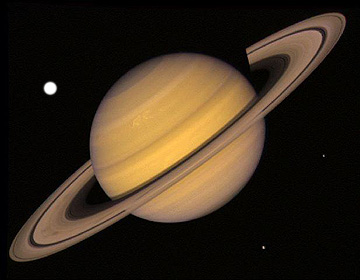

The rings begin about 7000 km (4345 miles) beyond the planet's discernible atmospheric edge and continue for another 74,000 km (45900 miles) out to the faint F ring (discovered by Voyager), giving this assemblage a diameter of greater than 260,000 km (161,460 miles). But, the entire system is only about 1.5 km (~1 mile) thick. We show you details of the ring structure in this color enhanced version, made by assigning red, green, and blue to clear, orange, and ultraviolet image frames respectively, chosen for its esthetic quality and to help distinguish its ring divisions:
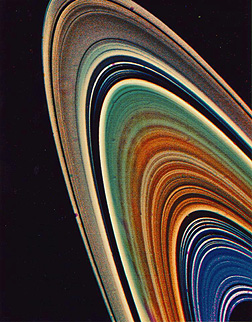
Note that there are many dark bands, which are gaps with lower densities of the centimeter to meters plus ice and ice/rock fragments that (although spread apart) reflect sunlight to create the visible rings. The inner blue region marks the C ring. Beyond it is the B ring whose inner part is orange and outer is greenish-blue. There is a large dark area known as the Cassini division (a gap) that separates the B from the outer (purplish) A ring. That ring is itself subdivided by the smaller Encke gap. Although not visible in this image, parts of rings (mainly in B) contain "spokes", narrow darker linear "shadows" that lie perpendicular to the bands; these may be density discontinuities or clusters of small particles levitated above the residual larger particles in the rings by electrostatic charging.
Saturn itself has about the same composition as Jupiter, but lower internal pressures and temperatures (up to about 12000° C) may limit the extent of the metallic hydrogen zone . Its density, ~0.7, is the lowest of any of the planets. Saturn's thin surficial atmosphere, although moderately banded, lacks the reddish coloration typifying Jupiter's belts but its yellowish color is similar to the Jovian zones. Circulation patterns driven by jets are also similar, including oval spots, cyclonic storms, eddies, and swirls.
Saturn has a system of 17 satellites, all but one (Iapetus) orbiting close to the planet's equatorial plane. Seven of these are spherical moons, ranging in diameter from about 400 to 5100 km (250 - 3170 miles). Their orbital positions outward from Saturn are (innermost) Mimas, Enceladus, Tethys, Dione, Rhea, Titan, and Iapetus (outermost). The remainder are smaller and irregular in shape (although Phoebe is nearly spherical), and are mixtures of ice and water. Of the larger, six appear to be almost entirely composed of water ice, but interior compositions are unknown. The seventh and largest, Titan, seems completely different, as will be described below. Most of the satellites have synchronous prograde (forward; ccw) orbits, locked by Saturn's gravity that causes each satellite's periods of rotation and revolution (about Saturn) to coincide such that the same hemisphere always faces the inner planet (as the Moon does the Earth). We will look at one or two representative images of each of the big seven, describing the satellite briefly.
Mimas is only 392 km (243 miles) in diameter. Its surface holds innumerable small craters. Because of the 136 km wide crater Herschel (approaching a size where disruption might have occurred), with its cyclopean eyelike visage, its resemblance to the Death Star ship in the Star Wars movie series has given it a special mystique.
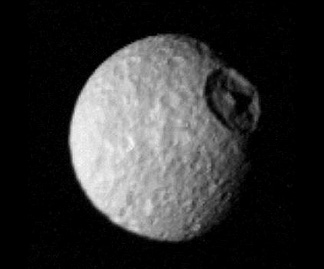
The larger (501 km [311 miles] diameter) Enceledus is the brightest object, in terms of albedo, in the solar system; this suggests regions of fresh or uncontaminated ice.
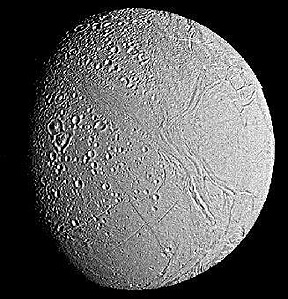
Five distinctive terrains have been established for this satellite: 1) Smooth Plains (craters sparse) 2) Cratered Plains (relatively few craters); 3) Cratered Terrain (more craters but still less than the other ice satellites, implying a rather young surface); 4) Ridged Plains (subparallel ridges); 5) Grooved Terrain (including graben-like, straight to curvilinear depressions). Some of these features are indicative of tectonic stressing of a brittle crust underlain by liquid, with the energy to fracture it coming from bulging in response to tidal interaction with Dione with which Enceladus is locked in orbital resonance.
Tethys is a heavily cratered satellite (diameter = 1060 km [658 mile]) on which is preserved a very large (~ 400 km [248 mile] diameter) impact structure called
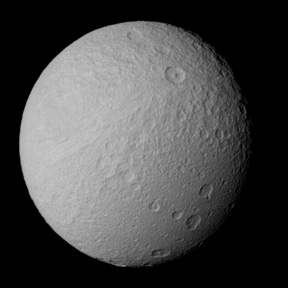
Odysseus whose rim and central peak have dissipated under viscous flow. A huge valley, 2000 km (1240 miles) long, 100 km (62 miles) wide, and up to 5 km (3 miles) deep, known as Ithaca Chasma, attests to the cracking of the ice as some stage, perhaps when rifting resulted as water converted to contracting ice that redistributed tension.
The slightly larger (1120 km [696 miles]) Dione has two dissimilar hemispheres: on one side, the leading hemisphere (because of synchronous locking, the same side
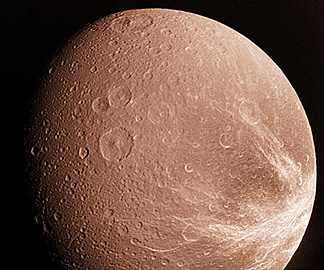
is always oriented towards the direction of advancing orbit) the surface is heavily cratered and fractured, with a uniformly medium bright tone. The other side, the trailing hemisphere, is darker, has much lower crater densities, and is characterized by broad, very bright streaks in a diffuse network; this strange pattern is believed to be frost and ice expelled or extruded from fissures and possibly from ice volcanoes (in which the water is the "lava" in an otherwise frozen structure).
Code 935, Goddard Space Flight Center, NASA
Written by: Nicholas M. Short, Sr. email: nmshort@epix.net
and
Jon Robinson email: Jon.W.Robinson.1@gsfc.nasa.gov
Webmaster: Bill Dickinson Jr. email: rstwebmaster@gsti.com
Web Production: Christiane Robinson, Terri Ho and Nannette Fekete
Updated: 1999.03.15.